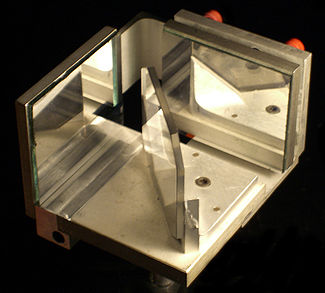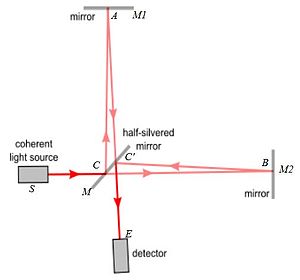- Michelson interferometer
-
 A Michelson interferometer for use on an optical table.
A Michelson interferometer for use on an optical table.
The Michelson interferometer is the most common configuration for optical interferometry and was invented by Albert Abraham Michelson. An interference pattern is produced by splitting a beam of light into two paths, bouncing the beams back and recombining them. The different paths may be of different lengths or be composed of different materials to create alternating interference fringes on a back detector. Michelson, along with Edward Morley, used this interferometer in the famous Michelson-Morley experiment (1887)[1] to show the constancy of the speed of light across multiple inertial frames, which removed the conceptual need for a luminiferous aether to provide a rest frame for light.
Contents
Configuration
A Michelson interferometer consists of two highly polished mirrors M1 & M2. A source S emits monochromatic light that hits a half-silvered mirror, surface M, at point C. M is partially reflective, so one beam is transmitted through to point B while one is reflected in the direction of A. Both beams recombine at point C' to produce an interference pattern (assuming proper alignment) visible to the observer at point E. To the observer at point E, the effects observed would be the same as those produced by placing surfaces A and B' (the image of B on the surface M) on top of each other. Let's look at this interaction in more detail. Imagine that we have two surfaces M1 and M2 as diagrammed.
 Path of light in Michelson interferometer.
Path of light in Michelson interferometer.
There are two paths from the (light) source to the detector. One reflects off the semi-transparent mirror, goes to the top mirror and then reflects back, goes through the semi-transparent mirror, to the detector. The other first goes through the semi-transparent mirror, to the mirror on the right, reflects back to the semi-transparent mirror, then reflects from the semi-transparent mirror into the detector. The principle is when a parallel beam of light coming from a monochromatic extended light source is incident on a half silvered glass plate, it is divided into two beams of equal intensities by partial reflection and transmission. Both beams are coherent. In this experiment coherent waves are thus produced by the method of division of amplitude.
If these two paths differ by a whole number (including 0) of wavelengths, there is constructive interference and a strong signal at the detector. If they differ by a whole number and a half wavelengths (e.g., 0.5, 1.5, 2.5 ...) there is destructive interference and a weak signal. This might appear at first sight to violate the principle of conservation of energy. However energy is conserved, because there is a redistribution of energy at the central beam-splitter in which the energy at the destructive sites is re-distributed to the constructive sites. The effect of the interference is to alter the share of the reflected light which heads for the detector and the remainder which heads back in the direction of the source.
In the late 1800s, the interference pattern was obtained by using a gas discharge lamp, a filter, and a thin slot or pinhole. In one version of the Michelson-Morley experiment, the interferometer used starlight as the source of light. Starlight is temporally incoherent light, but since it is a point source of light it has spatial coherence and will produce an interference pattern.
Applications
The best known application of the Michelson Interferometer is the Michelson-Morley experiment that provided evidence for special relativity. However, this configuration can be used for an assortment of different applications.
The Michelson Interferometer has been used for the detection of gravitational waves, as a tunable narrow band filter, and as the core of Fourier transform spectroscopy. There are also some interesting applications as a "nulling" instrument that is used for detecting planets around nearby stars. For most purposes, however, the geometry of the Mach–Zehnder interferometer is more useful. For the same path lengths, it will obtain a minimum due to zero phase shift on the internal reflection.
A further application is to produce a delay line interferometer that converts phase modulation into amplitude modulation in DWDM networks.
Astronomical interferometry is principally conducted using Michelson (and sometimes other type) interferometers. Principle operational interferometric observatories which use this type of instrumentation include VLTI, NPOI, and CHARA.
Nonlinear Michelson interferometer
Nonlinear Michelson interferometer, also known as Step-phase Michelson interferometer is a generalized Michelson interferometer in which one mirror in one arm is replaced with a Gires–Tournois interferometer or Gires–Tournois etalon. The field coming from Gires–Tournois etalon interferes with the plane field reflected from the ordinary reflector. Because the phase change from the Gires–Tournois etalon depends on wavelength and shows step-like behavior, nonlinear Michelson interferometer has particular applications. One notable application in fiber-optic communications is an optical interleaver.
The two mirrors in a Michelson interferometer can be replaced with two Gires–Tournois etalons. Such a nonlinear Michelson interferometer exhibits stronger nonlinearity, which can be used to construct an asymmetric optical interleaver.
LUPI
A variation of the Michelson that uses a small spherical reference mirror in one arm is often called a LUPI – laser unequal path interferometer. This setup needs a laser source, be it a tube laser or laser diodes – green or red.
This configuration is used to test large/small telescope mirrors.
A detailed write up on the first LUPI can be seen in the August 1972 issue of Applied Optics Vol 11 #8 pp 1872–74.There specifications are given for allowable cube beamsplitter (not single plate) thickness to be used with specific mirror focal length combinations with total allowable aberration limits for that setup detailed.
See also
- List of types of interferometers
- LIGO Laser Interferometer Gravitational-Wave Observatory
- VIRGO
References
- F. Gires, and P. Tournois (1964). "Interféromètre utilisable pour la compression d'impulsions lumineuses modulées en fréquence". Comptes Rendus de l'Académie des Sciences de Paris 258: 6112–6115. (Interferometer useful for the compression of frequency-modulated light pulse)
- ^ Albert Michelson, Edward Morley (1887). "On the Relative Motion of the Earth and the Luminiferous Ether". American Journal of Science: 333–345. https://secure.wikimedia.org/wikisource/en/wiki/Index:On_the_Relative_Motion_of_the_Earth_and_the_Luminiferous_Ether.djvu.
External links
- Diagrams of Michelson interferometers
- Application of a step-phase interferometer in optical communication
- European Gravitational Observatory
- A satellite view of the VIRGO interferometer
- A useful free software, to simulate and understand the Michelson interferometer principles, made by students of Faculty of Engineering of the University of Porto
- Block Engineering Michelson interferometer technology description
Categories:- Interferometers
Wikimedia Foundation. 2010.
